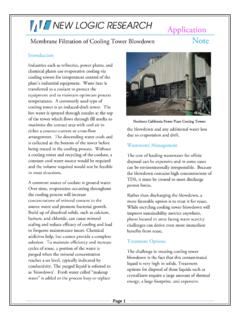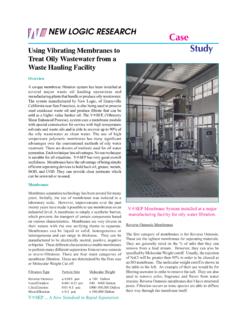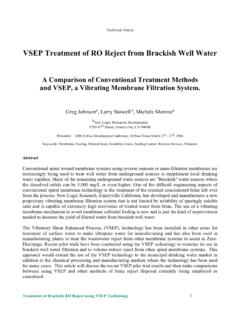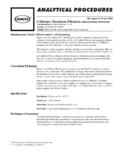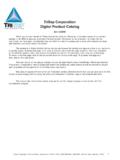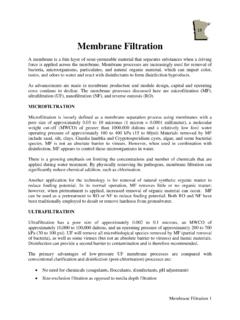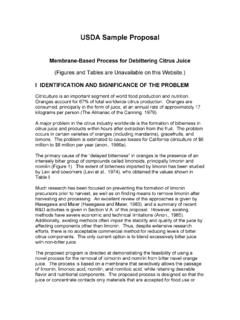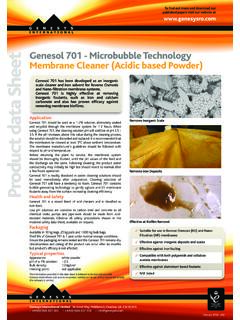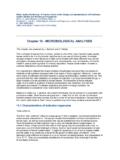Transcription of NEW LOGIC RESEARCH Technical Membrane …
1 IntroductionSome recent breakthroughs in themembrane filtration industry havenow made it possible for the treatmentof some previously difficultseparation applications. New plateand frame type Membrane modulescan tolerate very high levels of TSS,organics, and COD. Previousconventional Membrane modules withtight feed channels and limitedcrossflow capabilities were not ableto effectively handle the high foulingand plugging applications likeLandfill Leachate. Now, with moreopen high turbulence membranemodules that are resistant to foulingand plugging, membranes arebecoming a preferred option fortreating Landfill Leachate whencompared to conventional methodsthat have been used for many article discusses the newmembrane technologies and how theycompare to the existing methods usedat Municipal Landfills in the OperationsThe reason for having a landfill is tocontain waste and prevent it fromentering into the environment.
2 Inmodern landfills, the waste is actuallyencapsulated and sealed off to preventmigration of pollutants and key part of landfill design is thebottom liner on top of which the solidwaste is piled and compressed. Theliner is made of a rugged punctureresistant material like high-densitypolyethylene. The liner is alsosurrounded by compacted clay soil,geo-fabrics, and other layers are two ways for liquid to enterinto the landfill. One is in the trashitself. Landfills regulate the moisturecontent that is allowed when dumpingsolid waste. Slump tests and paintfilter tests are used to measuremoisture contents. Rainwater also cansoak into the landfill and will resultin leachate that must be treated. It isimportant to keep the landfill as dryas possible to reduce the amount run-off is collected usingditches and catch basins and isdiverted away from the coveredlandfill cells. The ditches are eitherconcrete or gravel-lined and carrywater to collection ponds.
3 In thecollection ponds, suspended soilparticles are allowed to settle and thewater is tested for leachate settling has occurred and thewater has passed tests, it is thenpumped or allowed to flow the cover of the landfill isporous, water does leach into thelandfill area. The water percolatesthrough the trash and picks upcontaminants along the way. Thedecomposition process breaks downthe solid waste and the introductionof water acts as a solvent to dissolvedigesting water that contains dissolvedcontaminants is called landfillleachate and eventually reaches thebottom of the cell where it starts toaccumulate. If the level of leachatesaturating the bottom layer of soilrises, the hydraulic pressure on theliner also increases. This pressuremust be relieved to prevent leaks andthe leachate is pumped out viadrainage piping that is filtration of Landfill LeachateAdvances in Module Designs Enhance Landfill Effluent TreatmentNEW LOGIC RESEARCHT echnical ArticleLeachate Control MethodsThe leachate is directed to a separateleachate collection pond.
4 Leachatecan be pumped to the collection pondor flow to it by gravity. A leachatecollection pond is designed to catchand isolate the contaminants that canget into the environment. The leachatein the pond is tested for acceptablelevels of various chemicals (biologicaland chemical oxygen demands,organic chemicals, pH, calcium,magnesium, iron, sulfate and chloride)and allowed to settle. After testing, theleachate must be treated like any othersewage/wastewater. The treatmentmay occur on-site or off-site. Theoptions for treatment includerecirculating the leachate back to thelandfill, treating for sanitary sewerdischarge, or treating for local surfacewater leachate may containcontaminants from the buried solidwaste, it must be prevented fromgoing outside the landfill boundariesor down into the a complex combination oflandfill liners, monitoring wells,piping, pumps, and capping of thelandfill, leachate flow is restricted andcaptured.
5 The wetter the climate, themore potential risk there is for leaksand attenuation of toxic , pesticides, batteries, andautomotive products deposited inlandfills contribute to the toxiccontaminant levels in the EPA estimates that billiongallons of wastewater was generatedat landfill facilities domestically in1992. EPA has proposed to regulatethe following landfill sources ofwastewater: leachate, gas collectioncondensate, truck/equipment washwater, drained free liquids, laboratorywastewaters, and has published its proposedregulations for Landfills as part of theClean Water Act. The new effluentlimitations are based on BestAvailable Technology (BAT)methods that have been surveyed andNEW LOGIC RESEARCHT echnical Article yyyyyy yyyyyyyyyyyyyyyyyyyyyyyyyyyyyyyyyyyy yyyyyyyyyyyyyyStorm WaterCatch BasinCapping SystemLiner SystemLeachateRemoval PipeLeachateStorage PondSolid Waste LandfillPrecipitationEvaporationLandfill Water MigrationTrend in Solid Waste lbs50100150200250 Pounds per Person per DayTotal Municipal Solid Waste GeneratedMillion TonsSource: Non-hazardous landfills areregulated under Subtitle D andhazardous landfills are regulatedunder Subtitle C of the ResourceConservation and Recovery Act (RCRA).
6 The proposal would alsoestablish pretreatment standards forthe introduction of pollutants intoPublicly Owned Treatment Works(POTWs) associated with theoperation of new and existingHazardous landfills regulated underSubtitle C of has identified several trends inthe waste disposal industry that mayincrease the quantity of leachateproduced by landfills. More stringentRCRA regulation and the restrictionson the management of wastes ingeneral have increased the amount ofwaste disposed at landfills as wellas the number of facilities choosingto send wastes off-site to commercialfacilities in lieu of pursuing on-sitemanagement options. This hasincreased the amount of solid wasteand also the amount of leachaterequiring landfills affected by the newregulation include 158 non-hazardouslandfills discharging wastewaterdirectly into local surface waters. Inaddition, there are 6 hazardouslandfills that discharge to POTWs thatare affected by the new of the remaining landfills havetheir own in-situ wastewater treatmentsystems and do not discharge wasteto surface waters or to POTWsTreatment Method ComparisonsThere are many methods of treatmentcurrently being used for landfillleachate.
7 The treatment technologiesinclude physical/chemical treatmentand biological treatment. Some ofthese methods include: Chemical precipitation Aerobic biological Anaerobic biological Carbon adsorption Multimedia filtration Reverse osmosis Air stripping Sludge dewateringEven though the treatment methodsvary, the most common conventionalmethods used include various formsof aerobic biological systems. Theseinclude aerated lagoons, activatedsludge systems, and sequential batchreactors. Biological methods havebeen successful, but do have someAlabama28 Alaska217 Arizona59 Arkansas67 California278 Colorado72 Connecticut11 Delaware3 Florida67 Georgia159 Hawaii10 Idaho37 Illinois61 Indiana32 Iowa77 Kansas58 Kentucky12 Louisiana29 Maine27 Maryland25 Massachusetts106 Michigan54 Minnesota26 Mississippi14 Missouri30 Montana82 Nebraska21 Nevada56 New Hampshire33 New Jersey14 New Mexico79 New York42 North Carolina114 North Dakota12 Ohio63 Oklahoma94 Oregon88 Pennsylvania47 Rhode Island4 South Carolina37 South Dakota13 Tennessee81 Texas678 Utah54 Vermont61 Virginia152 Washington25 West Virginia22 Wisconsin46 Wyoming59 Municipal Landfills in the United StatesTotal 3,536 Source EPANEW LOGIC RESEARCHT echnical Articledrawbacks.
8 The retention times arelong in order to enhance microbiology is sensitive to toxicheavy metals, loading rates, andtemperature variations. In addition,very often, several treatmenttechnologies must be used in a trainof unit operations in order to meeteffluent new regulations as part of theClean Water Act and with the adventof new technologies to address thisproblem, many municipal facilitiesare re-evaluating their existingmethods. One of the newdevelopments in wastewater treatmentincludes the new open channel plateand frame type polymeric membranefiltration systems. There are severaltypes including the Disk Tube Modulemade by Rochem and the VSEP(Vibratory Shear Enhanced Process)made by New LOGIC RESEARCH ofEmeryville, Osmosis was previously notappropriate due to narrow feedchannels. Now with this limitationremoved as in the wide channel flowNEW LOGIC RESEARCHT echnical ArticleLeachate Treatment Technology ComparisonsInitialPrecipitation SequenceActivated2 StageRaw Feedplus Biotower Batch Reactor Sludge RO Membraneppm (mg/l)
9 4626472147594687 ArsenicAs5842233122 BariumBa28031 ChromiumCr415123222822 CopperCu13954761 MolybdenumMo13,26013,26013,12727 NickleNi2,0601,9761,87910 SeleniumSe1781381780 TinSn9088867235 TitaniumTi23738220 ZincZn1261142471 BoronBo1,8081,2201,7281,540101 CyanideCn3,99027120 LithiumLi2662662391 SiliconSi4,3623,6773,9694,362353 StrontiumSr1,406391,23246714 AmmoniaNH458,480351234292 Total NitrogenTKN209,400155,5841,047 Total Suspended SolidsTSS171,8003,43647,932126,1012 Total Dissolved SolidsTDS2,478,0002,438,3522,373,9249,91 2 Biological Oxygen Demand BOD1,182,00041,37062,64628,3685,910 Chemical Oxygen Demand COD1,526,00061,040424,228360,13610,682 Total Organic CarbonTOC642,600216,556101,5313,213 Oil and GreaseO&G37,3335,5639,33337 Benzoic Acid7,6852369838P-Cresol7973724 Pheonol1,26219836 Tolulene37633282 Source: Development Document - Proposed Part C EPA Office of WaterTable , 8-4, 8-2membrane modules, RO membranesoffer an excellent alternative tobiological systems.
10 RO membranesare capable of very selectiveseparations and can achieve filtratequality better than any biologicalsystem. These membranes can also beused as a single unit op to handle theraw leachate flow and produce cleanwater in one step. RO membranes canbe used in parallel and in series tohandle any flow and produce anywater quality needed. Therefore, theyare not subject to the loading rate,toxic metals, and temperaturelimitations of biological plate and frame type membranefilters are installed in dozens oflandfills worldwide and are becomingmore and more accepted as anindustry MembranesWhile Reverse Osmosis is a fairlymature technology, the use of it forwastewater is a relatively newadvance. First used in the 1950s and60s, they were primarily used forseawater desalination and brackishwater applications. The advance ofmembrane chemistry and especiallythe invention of new thin filmcomposite membranes has widenedthe use of membranes.
